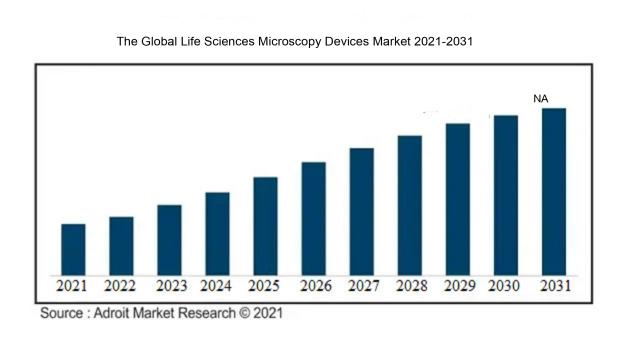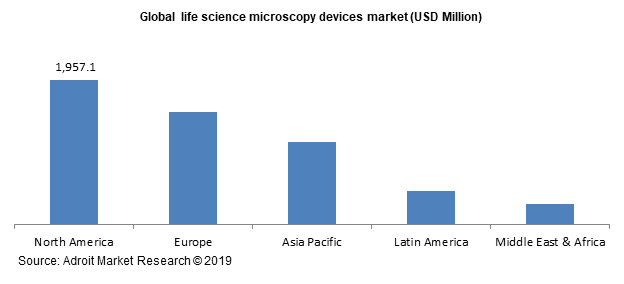The global life sciences microscopy devices market was valued at USD 5,334.2 Mn in 2018. Increasing drug discovery activities across healthcare segment and technological advancement in the microscopic devices together drive the life sciences microscopy devices market.
The Life Sciences Microscopy Devices Market is expected to reach XX in for Market size during the forecast period at a XX % CAGR 2031.

As per the latest research citing brought forward by World Health Organization (WHO), antibiotics resistance is a looming threat commonly encountered during the treatment of infectious diseases such as tuberculosis, pneumonia, sepsis diagnostics, gonorrhea, food borne diseases. It has become imperative to understand the microorganism’s ability to develop resistance against antibiotics by studying their metabolism. The hurdle faced by life science microscopy devices market is the low magnification power of the light microscopes. The opportunity related to the market is its rampant adoption of microscopy devices in educational and research institutes worldwide.
The major segments pertaining to the life science microscopy devices market are by device type and application. Optical microscopy devices and microbiology are leading the device type and application segment respectively.
North America is the clear leader in the regional segment holding 36.69% in 2018. Factors such as increasing RnD fundings, high adoption of technological advanced devices, and presence of significant number of players are major factors driving the growth of the market in the region. Asia Pacific is the fastest growing market on account of rising prevalence of infectious diseases and burgeoning requirement of novel drug delivery system development to counteract antibiotic resistance.
Life Sciences Microscopy Devices Market Scope
| Metrics | Details |
| Base Year | 2023 |
| Historic Data | 2018-2022 |
| Forecast Period | 2024-2031 |
| Study Period | 2018-2031 |
| Forecast Unit | Value (USD) |
| Revenue forecast in 2031 | NA |
| Growth Rate | CAGR of XX during 2021-2031 |
| Segment Covered | By Product Type, Application, Regions |
| Regions Covered | North America, Europe, Asia Pacific, South America, Middle East and Africa |
| Key Players Profiled | Olympus Corporation, Thermo fisher Scientific, Inc., Nikon Corporation, Carl Zeiss AG, Keyence Corporation, JEOL Ltd., Bruker, Hitachi High-Technologies Corporation, Leica Microsystems, and F. Hoffman-La Roche Ltd |
Key Segments of the Life Sciences Microscopy Devices Market
Product
• Scanning Electron Microscope
• Compound
• Transmission Electron Microscope
• Confocal
• Stereoscope
Application
• Microbiology
• Bioengineering
• Pharmacology
• Toxicology
• Cell Biology
• Pathology
• Neuroscience
End User
• Research Laboratories & Institutes
• Forensic and Diagnostic Laboratories
• Pharmaceutical Companies
• Biotechnology Companies
Regional Overview
North America
• US
• Canada
Europe
• Germany
• France
• UK
• Rest of Europe
Asia Pacific
• China
• India
• Japan
• Rest of Asia Pacific
South America
• Mexico
• Brazil
• Rest of South America
Middle East and South Africa
Frequently Asked Questions (FAQ) :
The microscopic devices finds immense application in various life science disciplines such as microbiology, cell biology, pathology, pharmacology, toxicology etc. It is noteworthy to understand that growing antibiotic resistance during treatment of infectious diseases has resulted in burgeoning requirement of understanding the microorganism metabolism. In depth study will help physicians worldwide to implement effective treatment regimen to counteract antibiotic resistance. Biopharmaceutical companies throughout the globe are investing heavily in their research & development wing for the novel drug development for treatment of vector borne diseases having no satisfactory cure. Increasing adoption of microscopic devices in academic research institutes, technological advancement in the optical lenses, generation of high resolution images bolster the life science microscopy devices market.
Medical device manufacturers are working diligently to achieve value addition to existing microscopic devices. Optical microscopy devices are highly employed for achieving high magnification images of cell organelles such as lysosomes, golgi apparatus, ribosomes etc. It is highly popular owing to its excellent ergonomic features and low device cost. Major players are continuously focusing in enhancing the resolution and magnification power of optical microscopy devices. Electron microscopic devices are majorly utilized in achieving precise images of microorganisms and drug molecule testing studies. Scanning probe microscopy devices are popular in generating real time 3 dimensional images of objects at atomic level.
Optical microscopic devices held the largest market in 2018, representing a market share of 44.92%. The major parameters responsible for its magnificent growth is growing adoption of optical microscopes in academic and research institutes worldwide. The optimum balance between the device price, excellent magnification and resolution power achieved -further bolster the optical microscopy devices market. The optical microscopes are further sub segmented as compound microscopy devices, confocal microscopy devices, phase contrast microscopy devices, fluorescence microscopy devices, stereo microscopy devices and others. Scanning probe microscopy devices will be growing at a faster pace on account of its capability to study real time 3-D shaped objects with high magnification.
_1.png)
In 2018, microbiology held the dominant market share of more than 20% in the application segment for life science microscopy devices. The key factors responsible for its positive market growth are increasing investment in the research and development of vaccines against life threatening vector borne diseases such as Zika, Ebola, Swine flu etc. Pharmacology will be growing at rapid pace during the forecast period owing to increasing drug development activities in the biopharmaceutical industry throughout the globe._1.png)
North America held 36.69% market share in 2018, for the regional segment of life science microscopy devices market. The primary factors responsible for its impressive market growth are increasing funds invested in the research and development of optical lens, magnification power and superior resolution of microscopic devices. The European Medical Agency (EMA) has expedited the clearance protocols for microscopic devices for its rampant adoption in research institutes in collaboration with major biopharmaceutical players for novel drug development. Asia Pacific will register faster growth during the forecast period on account of rising prevalence of infectious disease and developing healthcare infrastructure. Presence of major players such as Olympus Corporation, Nikon Corporation, etc., will further accentuate growth of the life science microscopy devices market in the region


